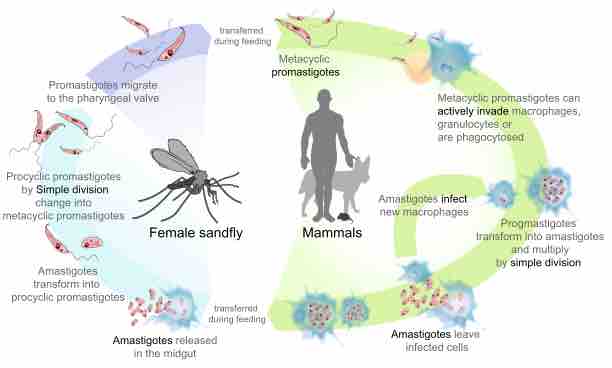Leishmaniasis is a disease transmitted by the bite of a female sandfly . There various types of leishmaniasis that exist including cutaneous leishmaniasis, systemic, or visceral leishmaniasis. Cutaneous leishmaniasis is characterized by infection of the skin and mucous membranes. The symptoms include skin sores which present at the site of the sandfly bite. In addition, cutaneous leishmaniasis includes breathing difficulty, stuffy nose, runny nose, nose bleeds, swallowing difficulty and ulcers in the mouth, tongue, gums, lips, nose, and inner nose. Systemic or visceral leishmaniasis present as an infection of the entire body. There is a delay of symptoms, ranging from 2-8 months post bite, and the effects on the immune system can result in deadly complications. The parasites damage the immune system by targeting the disease-fighting cells. Symptoms present much more quickly in children and include a cough, diarrhea, fever, and vomiting. In adults, there is fatigue, weakness, loss of appetite, abdominal pain, night sweats, fever, weight loss, and changes in the color and texture of the skin. In combination, cutaneous and visceral leishmaniasis are caused by more than 20 different leishmanial species.

Leishmaniasis
A Phlebotomus papatasi sand fly that transmits one type of leishmaniasis, next to an image of Leishmania sp. promastigotes from culture. This is the stage of the parasite that occurs inside the mid-gut of the sand fly.
Leishmaniasis is vector-borne because it is transmitted via a bite from a sandfly. The sandflies that cause leishmaniasis are infected by an obligate intracellular protozoa of the genus Leishmania. The species of Leishmania that can cause leishmaniasis include: L. donovani complex with 2 species (L. donovani, L. infantum, also known as L. chagasi); the L. mexicana complex with 3 main species (L. mexicana, L. amazonensis, and L. venezuelensis); L. tropica; L. major; L. aethiopica; and the subgenus Viannia with 4 main species (L. (V.) braziliensis, L. (V.) guyanensis, L. (V.) panamensis, and L. (V.) peruviana). These various species are indistinguishable via morphology but can be identified using advanced techniques such as isoenzyme analysis.
Leishmaniasis is transmitted by the bite of infected female phlebotomine sandflies which can transmit the infection Leishmania. The sandflies inject the infective stage, metacyclic promastigotes, during blood meals. Metacyclic promastigotes that reach the puncture wound are phagocytized by macrophages and transform into amastigotes. Amastigotes multiply in infected cells and affect different tissues, depending in part on which Leishmania species is involved. These differing tissue specificities cause the differing clinical manifestations of the various forms of leishmaniasis. Sandflies become infected during blood meals on infected hosts when they ingest macrophages infected with amastigotes. In the sandfly's midgut, the parasites differentiate into promastigotes, which multiply, differentiate into metacyclic promastigotes, and migrate to the proboscis.

Leishmaniasis life cycle
Leishmaniasis is a vector-borne disease and is transmitted by the sand fly.